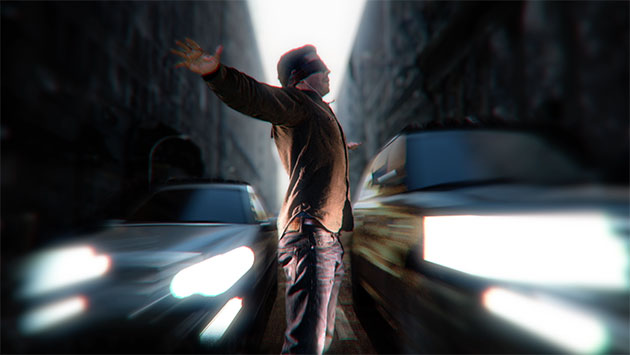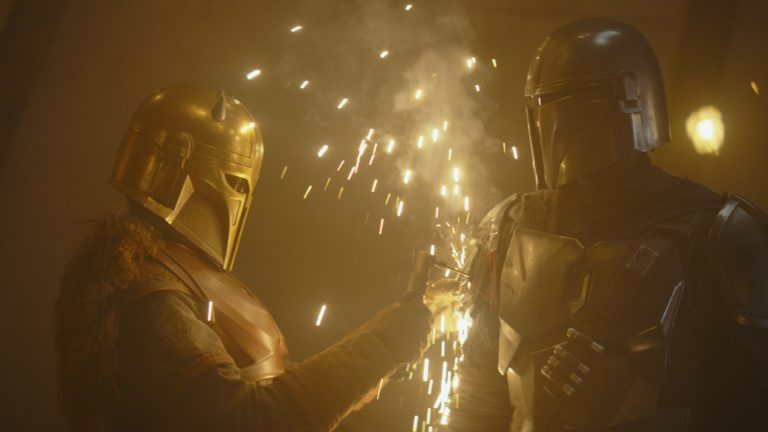How Filmmaker John Robson Used Green Screen and Digital Photogrammetry to Help His Actors Play in Traffic
In John Robson’s new short film, "Connect," a recently unemployed programmer named Carter (played by Andrew Houston) is home in his apartment staring worriedly at random strings of zeroes and ones scrolling across his computer screen. He’s looking for patterns that might indicate something big, perhaps terrible, is about to happen, and he is not alone.
Others out there are doing the same thing, including Moonchild (Nihan Gur), a stranger he is messaging with when suddenly the zeroes stop appearing as ones fill the screen and repeat over and over again. Whatever they have all been watching for has begun, leaving Carter panicked while Moonchild cryptically writes: “The future is in the code that you’re mining.”

One of Robson’s friends let him shoot these scenes in his apartment.
Robson [website], who relied primarily on Maxon Cinema 4D and Adobe After Effects to make the film, was inspired to write the script after reading a few stories about the Global Consciousness Project. Launched in the 1990s by researchers at Princeton, the real-life project aims to determine whether, and to what extent, human consciousness is connected to the physical world.
“They believe that when major events happen, like the attacks on 9/11 and the tsunami in Indonesia in 2004, patterns can be seen in the data a few days before,” Robson says, acknowledging that the idea is highly debatable. “But it makes a good starting point for a story.”

Robson (center/right in the black shirt) and some of the cast and crew review a scene they just shot.
Here, Robson explains the making of "Connect," which leaves viewers wanting to know what happens next. Fortunately, he’s already working on a second short and is also writing a feature-length script, which he’d like to see made into a movie.
StudioDaily: You’ve been a freelance director and motion designer for more than a decade, what are some of the projects you’ve been working on recently?
John Robson: This year I’ve split my time between freelancing at studios and developing new projects from my home office. In addition to commercials, a lot of new media jobs have been coming down the pipeline, such as live concert visuals, installations and virtual reality jobs. One recent job was creating two hours of screen content for NBC’s live performance of The Wiz. Instead of practical stage backgrounds, everything was made digitally and projected on massive LED screens behind the talent and a D3 operator would queue up movies for playback in real time. It’s an interesting time in our industry, because jobs no longer follow the same rigid pipelines, and a lot can be done by a small team working remotely instead of in a big studio.
In your free time you’ve made a couple of films—Red Within and Epoch [previously at StudioDaily], but "Connect" is a much larger project, maybe even a feature. What are your plans?
I’ve already shot the companion film to "Connect" and I’m doing post-production work on it and will eventually submit it to festivals. That film, "Moonchild," covers the same day that you see from Carter’s perspective in the first film, only this time it’s from Moonchild’s perspective.
Hundreds of photos were taken on location from different angles and stitched together using PTGui to create a rough 3D layout of the scene.
Both stories funnel into the feature-length script that I’ve been working on. The writing hasn’t been easy. The complexity of the pseudo-science behind the film is pretty crazy, so that’s been the biggest struggle so far. It’s hard to figure out how to create logic that doesn’t exist and make sure that it doesn’t contradict itself.
"Connect" has a techy theme but kind of a 1990s look. Would you say that’s right, and is that intentional?
It is, yes. I think of this film as an homage to the low-fi sci-fi films that I grew up with in the 90s. Visual effects hadn’t matured at that time, so everything was not yet done in CG. There was a grittiness that I liked, and I’ve tried to do some of that here. Still, my film does have a lot of CG, but I used it as a way to cut costs as a guerilla film maker and take advantage of my post-production skills. I also wanted to avoid having the cast get hit by cars.
Can you talk a little bit about your process? Do you start with storyboards?
Ever since "Epoch" I’ve created my own storyboards. They’re really awful, but they help because I’m able to map out the whole film and put it into an edit so I can figure out shots and timing. I even do a read of all of the voices, which is embarrassing and hilarious, but I try to prepare as much as possible before we shoot so there is nothing to worry about except moving from A to Z.

Robson’s boards may be simple, but they allow him to map out the storyline of his films and save time and money.
How did you handle the complicated street scenes?
We shot what we could, but we looked into getting a permit and realized we couldn’t because they cost thousands of dollars in L.A. for just a few hours, and that’s just shooting on the sidewalk. So we shot it guerilla-style in the most critical order we could plan to be sure we got all of the wide shots we needed. Our crew was really small, and we had a telephoto lens across the street from Carter.

Working with blindfolded actors was difficult at times, but the team managed to get the choreography right after several attempts.

It helped that Andrew Houston, who played Carter, was already trained in martial arts so the moves weren’t difficult for him.
We did everything else on green screen, which took a lot of repetition and rehearsing, but after some practice we nailed it. I created an animatic in Cinema 4D of all of the action that goes on with the cars zooming by. It was almost like dance choreography, trying to figure out where each car was, what lane Carter was in and how he would dodge each vehicle coming at him.

Shot on green screen, Andrew Houston’s moves look effortless in the traffic scenes.
I had everything perfectly time out, and we pulled it off by using digital photogrammetry, where you shoot photos of a location and then stitch them together to make a 3D environment in Cinema and Octane.
Did you render everything in Octane?
I did. I’d been experimenting with it a lot in my home studio and it’s amazingly fast. I used this project as a litmus test and now I use it extensively.
How did you create the scenes with the coins flipping in the air?

The coins were built from simple models to optimize simulation times.
Textures were created by analyzing photos of real coins with CrazyBump, which generated bump and specular maps from the images.
That was all done in C4D, with simple dynamics and rendered in Octane. The most important thing was to have it feel realistic, so I made sure they reacted properly dynamically. It took some experimenting but I got the look I wanted pretty quickly.
And what about the scenes with the molecules? You use those a lot when the narration is explaining the science.
For those, I used a cloner of a bunch of spheres on a spline. The spheres have dynamics to them so they push each other apart. I had them grow and appear along the line as if it was a chemical reaction traveling down a path. I just really wanted to make something from scratch, and I wanted it to feel very explosive and organic.
Molecules were made from scratch and intentionally look explosive and organic.
Subsurface scattering gave the molecules a translucent look. In this scene, the molecules have changed and are moving beyond Carter, out into the air.
What are you working on now, professionally and/or personally?
Lately I’ve been taking on more creative direction and concept work as a freelancer. I’ve also been involved in a number of VR projects that have been exciting because it’s such young medium right now. I think artists are redefining the boundaries and potential of virtual reality every day, and it reminds me of the early 2000s when the language of motion graphics was still being written. I’m currently directing two VR films that use a blend of live action and C4D that will be released in the next few months.
Meleah Maynard is a freelance writer and editor in Minneapolis, Minnesota.
Crafts: VFX/Animation
Sections: Creativity
Topics: adobe After Effects cinema 4d john robson Maxon short film
Did you enjoy this article? Sign up to receive the StudioDaily Fix eletter containing the latest stories, including news, videos, interviews, reviews and more.















Leave a Reply